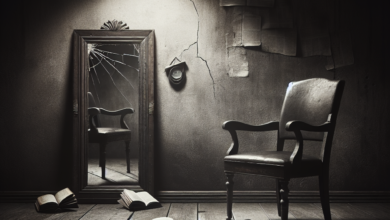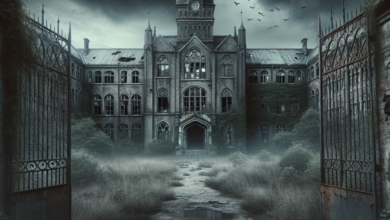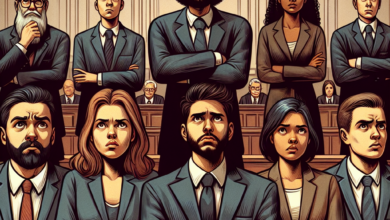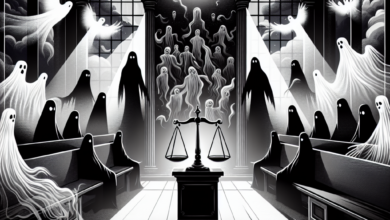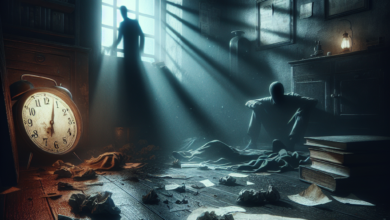Title: The Facade of Justice
Part 1: The Unraveling Threads
In the small, seemingly idyllic town of Linwood, the sun hung low in the sky, casting elongated shadows on the cobblestone streets. The murmurs of the marketplace were a charming symphony, vendors hawking their goods, children laughing, and old friends catching up over a cup of coffee. On the surface, Linwood appeared to be a community bound by trust and goodwill. But beneath this veneer lay a hidden darkness, simmering just out of sight—an unsettling reality for those courageous enough to confront it.
At the heart of Linwood stood the imposing structure of the Justice Hall. The building was a relic of a bygone era, with its grand columns and detailed stone carvings. Inside its walls, however, lay more than just the chambers of law; it was a place of secrets, betrayals, and unyielding ambition. The current District Attorney, Evelyn Chase, had climbed to her position through a mixture of intelligence and ruthless ethics. She believed she was the protector of the innocent, yet in the shadows of her loftiness, her ambition twisted the meaning of justice.
When Timothy Lyle was arrested, it barely made a blip on the town’s radar. He was a local carpenter, known for his kind demeanor and strong work ethic. But when a series of robberies plagued Linwood, fingers quickly pointed to him. On the night of the last heist, a local shopkeeper had been found battered, and all evidence led back to Timothy. The townsfolk were quick to assume the worst, their comfortable lives disrupted by the turmoil of uncertainty.
Evelyn saw an opportunity for a swift conviction; with the right narrative, she could bolster her already-enviable reputation. She organized a rally to publicly support the impending trial, gathering the townspeople in the square to assure them that justice would be served swiftly. "These are troubled times," she began in a resonant voice that commanded attention. "We cannot allow crime to fester in Linwood. We must act, vigilantly and decisively."
Though no one ever imagined Timothy capable of such heinous acts, the collective anxiety turned into a fervor for justice, and Evelyn’s narrative took root. The facade of justice was emerging—a staged play, where the truth remained buried beneath layers of performative righteousness.
Part 2: The Advocate’s Descent
As the trial date approached, an unlikely character found herself embroiled in the web of deceit. Clara Thompson was a recent law graduate, driven by a desire to champion the underprivileged. She had always held justice close to her heart, witnessing too many injustices during her time in law school. When she learned that Timothy was facing an uphill battle, she felt compelled to step in and offer her services as his defense attorney.
Clara was young and idealistic, viewing justice as a noble pursuit. She believed that every individual deserved a fair chance in the eye of the law—an idea that seemed increasingly foreign amongst the smoldering tension in Linwood. “You have to fight for every inch, Clara,” her professor had warned her, his voice heavy with cynicism. “Justice is just a facade, my dear. What lies beneath it is far more complex.”
But Clara pressed on, diving headfirst into Timothy’s case. In the meager confines of the public defender’s office, she sifted through files and analyzed testimonies. The evidence against Timothy was overwhelming, yet there were inklings of doubt. Witness accounts were shaky, and the alibis seemed to disappear under scrutiny. She knew she had to dig deeper.
As Clara uncovered the truth, she found herself drawn into a web of deception. The shopkeeper’s injuries, initially deemed to be the result of the robbery, presented inconsistencies. It became clear someone might have a motive to harm him beyond the robbery—someone with ties to the very people in power. Clara’s instincts screamed at her. The pressure was mounting, and Evelyn’s fervent push for a conviction left little room for doubt in the minds of the townspeople.
“Clara,” Timothy said during one of their meetings, his lined face revealing the exhaustion that burdened him. “You believe me, don’t you?”
“I want to, Tim,” she replied gently. “But it’s not just about what I believe. It’s about what the evidence says.”
As trial day erupted upon them, Clara walked into the courtroom filled with trepidation. The air was thick with tension; the townspeople had turned out in droves, holding banners that proclaimed, “Justice for Linwood!” and “No More Crime!” As the judge entered, Clara felt the weight of the entire town’s expectations upon her shoulders. But she was equipped with new evidence—a surveillance tape showing another man near the shop at the time of the robbery. The truth, however, crumpled under the weight of the facade.
Part 3: The Grasp of Power
Evelyn was not about to let another opportunity slip through her fingers. She stood across the aisle with a calm ferocity, her sharp gaze flickering like the flame of a candle poised at the edge of the wind. The tape, despite its presence, became an obstruction for her narrative. A few questions posed by her to the store owner—casting doubt on the veracity of the tape—turned the tide against Clara.
“Your Honor,” she asserted, raising her voice above the murmur of dissent, “this evidence raises doubt but does not absolve Mr. Lyle of his actions. The community has suffered, and they demand resolution. We must hold him accountable!”
It was a gambit designed to elicit an emotional response from the jurors, a tactic Clara had prepared for. But the energy in the room shifted. The tension myopically tightened on the represented ideals of justice, loyalty, and fear. Emotion flared in the courtroom, drowning the rationality that Clara fought so hard to protect.
Indomitable and relentless, Evelyn had an uncanny aptitude for manipulating perceptions. The trial spiraled into chaos, Timothy’s fate hanging by a thread as Clara desperately tried to counter every blow aimed at his character. The spotlight, which had been intended to shine upon truth, now reflected the shadows of ulterior motives.
With every passing day of the trial, Clara discovered more profound depths to the façade. The betrayal ran deeper than mere ambition; Evelyn wielded her power like a sword, severing any ties to morality in her pursuit of reputation. Whispers of corruption echoed within the law office halls and the justice system seemed frail, like the cracks beginning to show in the courthouse’s aging facade.
Part 4: The Turning Point
In an unexpected twist of fate, Clara found solace in a hidden piece of evidence—a local man had filmed the robbery without realizing its significance. The raw footage, devoid of skillful editing or manipulation, showed not only Timothy’s innocence but also to whom the real crime was tied. With trembling hands, Clara secured a meeting with the individual, determined to prove Timothy’s innocence once and for all.
“You have to understand, they’ll come after you,” the elderly man warned her. “Evelyn Chase isn’t just any attorney; she has the weight of this town behind her.”
Clara nodded, steeling herself. No longer could she sit idly by. The truth would surface even if she had to contend with the storm that lay ahead. That evening, as the sun dipped below the horizon, Clara resolved to take a stand. She gathered her findings with renewed vigor, reconnecting the web of deception Evelyn had spun.
On the day of the closing arguments, Clara stood before the jury with a burning passion in her eyes. The room was silent, save for the rustle of papers as she laid out her evidence. Evelyn braced for battle, confident in her ability to sway the jury until Clara turned the tide.
"Ladies and gentlemen of the jury," Clara began, her voice steady despite trembling legs, "truth should not be swayed by fear, but it’s our responsibility to face it. Timothy is innocent—this footage shows the real perpetrator. If we ignore the evidence, we sacrifice not only Timothy’s future but the very fabric of our justice."
Victory hung in the air as Clara gestured towards the projection screen, illuminating the sincerity of her statement. But Evelyn was unyielding. “You’ve chosen to lead us down a dangerous path, young attorney. We cannot allow chaos to reign. We have a duty to protect our community.”
Tension pierced the courtroom once more, the audience caught in a battle pitting truth against the facade. A verdict was imminent, yet uncertainty loomed; the veneer of justice was beginning to show cracks, but would it shatter?
Part 5: The Verdict
After hours of deliberation, the courtroom gathered in anticipation—the air thrumming with unease. Clara clasped her hands, praying for an outcome that would lean towards justice. Timothy stood beside her, his eyes filled with anxiety that mirrored her own.
When the jury filed back into the room, the foreman’s voice broke the silence, “We, the jury, find the defendant, Timothy Lyle—”
Gasped breaths echoed through the chamber. The facade of justice hung perilously in the balance. “—not guilty.”
A ripple of shock coursed through the audience. Clara’s heart soared at the sound, but the victory was overshadowed by the overwhelming chaos of the townsfolk’s response. Some erupted in cheers, while others expressed outrage. Evelyn’s face darkened, a storm brewing behind her composed facade.
The moment was bittersweet. Timothy was free but the facade of justice had crumbled, revealing the underlying chaos beneath. In this township, righteousness had wrought havoc upon pride and power. Clara knew that only a deeper investigation could cleanse the system and restore faith in justice.
Part 6: The Aftermath
But the aftermath was tumultuous. Which secrets lay buried as Evelyn made her frantic phone calls, desperate to uphold her career while the world around her spun into disarray? Clara wasn’t satisfied with mere victory; she had witnessed the deterioration of ethics. She spearheaded a community forum aimed at exposing injustices, rallying townsfolk to demand accountability from those in power.
In the weeks that followed, the dialogue shifted from mere retribution to reflection. Linwood, though once a town blind to the undercurrents of betrayal, began to scrutinize its justice system more closely. Evelyn, once triumphant, became a shadow of her former self. Clara eased into her role as an advocate, fighting diligently for the voiceless and the wrongly accused.
Evelyn’s facade began to crack further, facing investigations of her own. As her allies abandoned her, she was unmasked, a casualty of her own ambition. The landscape of Linwood transformed as the townspeople began to understand that justice is an ongoing journey—an unyielding battle against complacency.
Clara stood at the forefront, embodying the spirit of change, ready to confront every injustice head-on. The truth was but the first step, yet it offered hope for a future where justice could flourish; where the facade would no longer dictate how they lived.
Epilogue: New Beginnings
Months later, Linwood basked in the warmth of late summer, a time for change and renewal. Clara walked through the same marketplace where whispers once haunted her, carrying the remnants of victory deep in her heart. Change was slow, but undeniably palpable.
Timothy thrived, opening a carpentry school aimed at aiding troubled youth in honing their skills away from crime. Evelyn faced her reckoning, uprooting the misleading narratives she’d supported; she could no longer hide behind her facade.
The stage was set for a new beginning—a path forged from the lessons of yesterday, illuminating a brighter future. Clara was prepared to fight against every injustice, ensuring that the real face of justice would shine brightly for everyone in Linwood—a truth forever untethered from the guise of mere appearances.
As the sun dipped below the horizon once more, Clara looked out at the community she had fought for, ready to embrace whatever came next, for the facade of justice had finally fallen, and beneath it lay the hope they all deserved.

